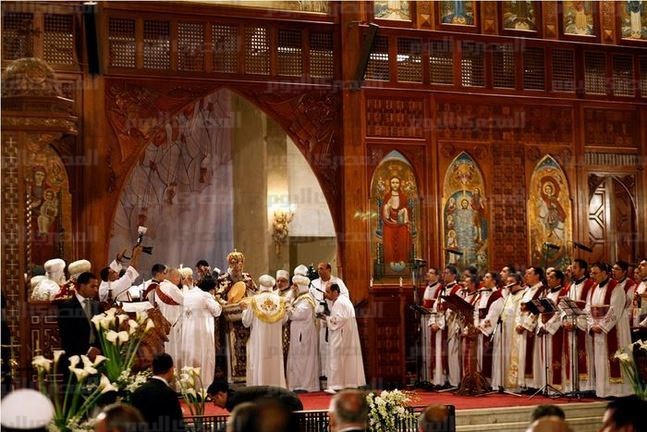Egypt’s revolution was leaderless, but not everyone got the memo. Today legions gravitate towards one notable or another, one visionary or another, one sheikh or another, one demagogue or another. There are those who self-describe as “Hazemoon,” the followers of Sheikh Hazem Salah Abu Ismail, and those who consider themselves among the ultras of Mohamed Elbaradei. There are those who see the Brotherhood’s Supreme Guide as clairvoyant and those who mourned for months the death of Pope Shenouda as if a connection to God had been permanently severed. Some flock after Sheikh Wagdy Ghonim’s fiery vitriol and others watch hours of online inflammatory videos from defrocked and exiled Father Zakaria Botros. In the end, there’s plenty of hand-kissing going on these days. At a time when Egyptian institutions are fighting for their survival, celebrity messiahs, saviors, and deliverers are a pound a dozen. They are auxiliary instruments whose seemingly rogue contrarian posturing does little beyond nudge age-old institutions toward greater hegemony over society.
All institutions have inherent problems, which are magnified and aggravated within religious institutions specifically. They are hierarchical structures that emphasize conformity, render subjects dependent, and enshrine a chain of command. Their process of specialization in their ranks leads to ultra-specialization and the disappearance of peripheral vision. Designed to increase efficiency and improve transfer of talent, information, and resources, they are instead killing the spirit of inquisitiveness, destroying intellectual curiosity, and digging a grave for Egypt’s polymaths.
Take for instance Al-Azhar, which without necessary testimony is an institution of remarkable repute and international acclaim, and one of the oldest academies in the world. Over the past 60 years, Al-Azhar has slowly relinquished its independence and become subservient to the state. With its work limited to reaffirming the priorities of the sitting government, the state’s hegemony of Al-Azhar ensured its ability to guide religious jurisprudence was either severely hindered or effectively harmonious.
Not long ago, an education at Al-Azhar was the most sought after by sons of the working class in the country’s governorates. Because of the clout attributed to Azharite education in rural Egypt, hundreds of thousands migrated to Cairo over the past three generations to become seasoned in religious affairs and return to respectable jobs in their hometowns. Simultaneously over the past few decades and very much on the same grounds in the country’s towns and villages, the Muslim Brotherhood developed its confessional and doctrinal platforms in the political, economic, and social realms, expanding their reach almost in parallel to Al-Azhar.
The two have avoided confrontation, at least overtly, for much of the past few decades, with only occasional spats between the Supreme Guide and sheikh of Al-Azhar. Neither was prepared to throw the other under the bus, but both understood that they were on overlapping territory. Despite supporting their political adversaries, Al-Azhar avoided incriminating the Brotherhood entirely (although they were spectators as the former regimes harshly punished them). In return, the Brotherhood consciously decided not to undermine Al-Azhar in their working class strongholds.
The January 25 uprising and the ensuing turmoil have left Al-Azhar utterly disoriented. With its ability to control its own institution hindered, Azharites have splintered with elements supporting the Brotherhood, others critical of both the Brotherhood and the Salafis, and others siding with the amorphous leftist nationalist revolutionary fronts. With Al-Azhar incapable of pulling its rank, the Brotherhood and Salafi groups filled the void by taking advantage of the institution’s delayed and reluctant public statements and dwindling reach. As if punishment for their former collusion with the Mubarak regime, Al-Azhar is now being marginalized by the Brotherhood. Nowhere was this more glaring and startling as when Al-Azhar Grand Sheikh Ahmed al-Tayyeb was seated at the back of an auditorium for President Morsy’s speech at Cairo University ahead of his swearing in. Al-Azhar’s proud pontiff stormed out in defiance and displeasure. Al-Azhar’s tug of war with the Brotherhood cuts across the breadth of the state infrastructure, the most recent being Prime Minister Hesham Qandil’s choice of Salafi Sheikh Mohamed Yosri Ibrahim as minister of endowments, a choice Al-Azhar vehemently rejects. Having lost control of Islamic airwaves and the growing appeal of political Islamist parties not under Tayyeb’s reign, Al-Azhar’s fort looks weaker than ever.
Even on the Constituent Assembly, Islamists negotiating with the Supreme Council of the Armed Forces and other political groups insisted that Al-Azhar’s designated seats be considered among those of civil society not the Islamist current. So the marginalization of Al-Azhar has become systematic, perhaps to the positive effect of deinstitutionalizing its revered stature or demystifying religion, perhaps in egalitarianizing it, or maybe in shattering the blind acceptance that is so obdurate within it. However, there is every indication that what might replace Al-Azhar’s religious reach will emulate its most undesirable qualities and ignore its most commendable. If the Muslim Brotherhood and the Salafi groups prevail they are likely to reproduce Al-Azhar’s hierarchy, already evident in their preexisting structure, while hastily and clumsily dismissing Al-Azhar’s most redeemable quality — careful and studious scholarship on matters of faith and practice.
As for the church, Al-Azhar’s twin, there is no questioning that the institution is now bearing the brunt of its most misguided, albeit well-intentioned, decisions and actions over the past few decades. While its history of nationalistic commitment is luminous, it has however engineered, largely out of fear and clientalism, a near-absolute annexation of all aspects of private and public life for Egypt’s Copts. Beyond the church’s original task of spiritual guidance, it subsumed everything from their children’s sporting activities to their secular celebrations.
This was all done with the state’s support and guidance. In the end, as far as Mubarak was concerned, no Coptic matter cannot be resolved by a single phone call to Pope Shenouda. So the state guaranteed Christians safety from the propped up perennial ghost, the Brotherhood, in exchange for unequivocal silence and blind obedience. This could only be delivered if the church had full and unchallenged control over the community, both politically and socially. And the church succeeded and delivered precisely that.
Today, the times are changing as the church finds itself in the same predicament as Al-Azhar. It is literally bursting at the seams. While some Christians are fearful of the days ahead, opting to escape the country by any means, the vast majority are here to stay. They are vocalizing and actively participating in all aspects of public life. No longer passively agreeing to the church’s representation of their political will or best interests, they ceased to be the same old unified front. Instead they act and engage as citizens. Their visibility is also at an all-time high.
Nevertheless, the church remains, through its Millet Council and governance bodies, forceful in its intent to speak for the country’s religious minority, something many Copts refuse. The most evident moment of defiance of the church was when the Coptic Maspero Youth Union chanted against Pope Shenouda for forgivingly hosting the SCAF’s top brass after the 9 October 2011 massacre. For much of the last 18 months, the church has tried every tool at its disposal to bring such revolutionary Coptic groups under its wing, but to no avail. In the end, the patriarchy, like Al-Azhar, is at a crossroads. Neither seeking refuge with the military or siding with the Muslim Brotherhood is favorable.
In the end, and despite the turbulence, Al-Azhar and the church will outlive this episode, each relying on their legacy, authority, and constituency. Al-Azhar will likely end up with the constitutionally-sanctioned last say on all Sharia-related matters and the church will continue to preside over Christian affairs, making them both mirror images of each other.
The irony is that without exception, all parties in this Olympiad of constitutional and political competition over power and prestige (the SCAF, the Muslim Brotherhood, Salafis, Al-Azhar, the church, etc.) are embodiments of counterrevolution. They are counterrevolutionary in their classist schisms, rigid hierarchy, deification of authority, commitment to neoliberal economics, and admonishment of dissidence. Assuming all religious institutions are well meaning and benevolent, we still see how their love, affection, and care for their subjects have turned tutorship into sponsorship, protection into oppression, and guardianship into custody. For this reason, the late activist Mina Daniel and Azharite Sheikh Emad Eddin Effat, both killed while disobeying draconian decrees to avoid revolutionary struggle, represent critical dissenting currents. While Al-Azhar, the church, the Brotherhood and other deep organizations learn from their margins, there are little indications this is happening. It is not in the nature of paternalistic institutions to willfully forgo saintly patronage over “their” masses.
Adel Iskandar is a media scholar and lecturer at Georgetown University.
A shorter version of this article was originally published in Egypt Independent's weekly print edition.




